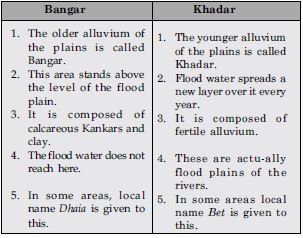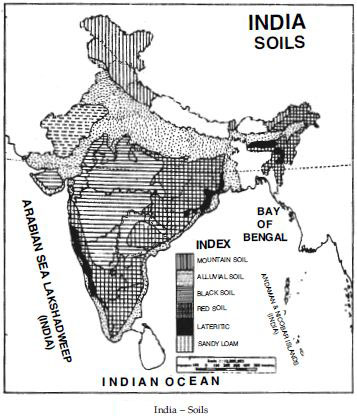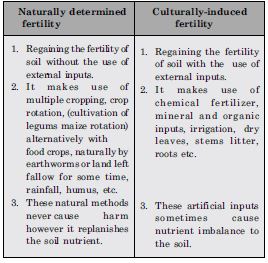Question 1:
Which one of the following is the most widespread and most productive category of soil?
- Alluvial Soil
- Laterite Soil
- Black Soil
- Forest Soil
Answer:
(a). Alluvial Soil
Question 2:
‘Regur Soil’ is another name for the
- Saline Soil
- Arid Soil
- Black Soil
- Laterite Soil
Answer:
(c). Black Soil
Question 3:
Which one of the following is the main reason for the loss of the top soil in India?
- Wind Erosion
- Water Erosion
- Excessive Leaching
- None of these
Answer:
(a). Wind Erosion
Question 4:
Arable land in the irrigated zones of India is turning saline due to which of the following reasons?
- Addition of gypsum
- Over Grazing
- Over Irrigation
- Use of Fertilisers
Answer:
(c). Over Irrigation
Question 5:
What is soil?
Answer:
The topmost layer of the crust is called the crust. It is the most important layer of the earth’s crust and is a valuable resource. Soil is the mixture of rock debris and organic materials which develop on the earth’s surface.
Question 6:
What are the main factors responsible for the formation of soil?
Answer:
The major factors affecting the formation of soil are
(a) relief
(b) parent material
(c) climate
(d) vegetation and other life-forms
(e) time.
Besides these, human activities also influence it to a large extent.
Question 7:
Mention the three horizons of a soil profile.
Answer:
Soil consists of three layers which are called horizons.
(a) ‘Horizon A’ is the topmost zone,
(b) ‘Horizon B ’ is a transition zone between the ‘horizon A’ and ‘horizon C’,
(c) ‘Horizon C ’ is composed of the loose parent material.
Question 8:
What is soil degradation.
Answer:
Soil degradation can be defined as the decline in soil fertility, when the nutritional status declines and depth of the soil goes down due to erosion and misuse. Soil degradation is the main factor leading to the depleting soil resource base in India. The degree of soil degradation varies from place to place according to the topography, wind velocity and amount of the rainfall.
Question 9:
What is the difference between Khadar and Bhangar?
Answer:

Question 10:
What are Black soils? Describe their
formation and characterstics.
Or
Describe the extent, characteristics and
distribution of Major Soils in India.
Answer:
Soil. Soil is the loose material which forms the
layer of mantle rock. India is primarily an agricultural
country. The success of agriculture depends upon the
fertility of soils. The soils of India are classified into three
main groups depending upon the rock cover and climatic
conditions :
(A) Soils of the Peninsular India.
(B) Soils of the Northern Plains.
(C) Soils of the Himalayas.
(A) Soils of the Peninsular India.
(1) Black soils. Black soils are mainly found over
the Deccan Lava tract including Maharashtra, Madhya
Pradesh, Gujarat and Andhra Pradesh. These soils are
found in river valleys of Narmada, Tapti, Godavari and
Krishna. These soils have been formed due to
weathering of Lava rocks. These soils cover an area of
about 5 lakh sq. km. These soils are rich in lime, iron,
magnesia and alumina. But these lack in phosphorus,
nitrogen and organic matter. These are also called
‘Regur’ Soils. These soils are most suitable for cotton
cultivation and are known as ‘Black Cotton Soils’.
These soils are compared with Chernozem soils of

Russia and Praries soils of U.S.A. These soils can hold
water. These soils are suitable for rice, wheat, jowar,
sugarcane, tobacco and oil seeds.
(2) Red Soils. These soils are found in Tamil Nadu,
Karnataka, Andhra Pradesh and areas on periphery of
Deccan Plateau. These soils have been formed due to
decomposition underlying Igneous rocks. The red colour
of these soils is due to oxidation and diffusion of iron in
hard crystalline rocks. These are given to the cultivation
of millets, pulses, linseed, tobacco etc. These soils cover
the largest area in Peninsular India. These soils are
poor in lime, nitrogen and humus. Fertilizers are added
to make these fertile.
(3) Laterite Soils. Laterite soils are found on the
highland areas of the plateau. These are found in
Karnataka, Kerala, Tamil Nadu and hilly regions of
Assam, Rajmahal hills and Chhotanagpur plateau. Due
to monsoonal climate (wet and dry seasons alternately
occurring), there is the leaching of soils. It washes away
the silica current in soils. These are shallow, acidic and
less fertile soils. The lowland laterite soils are useful for
cultivation of foodgrains and other crops. The upland
laterites are thin, coarse and infertile. These soils are
poor in nitrogen and lime, but rich in iron. So these are
suitable for plantation crops like tea, rubber, coffee,
etc.
(4) Alluvial Soils. These soils have been deposited
by the rivers in river valleys of Mahanadi, Godavari,
Krishna and their deltas. These are deep and fertile
soils. These are dark soils. These soils are suitable for
cultivation of Jute, Rice, Sugarcane etc.
(B) Soils of the Northern Plains
(1) Alluvial Soils. These soils are the most wide
spread soils covering an area of 8 lakh sq. km. from
Punjab to Assam. These cover about 43.7% area of India.
These soils have been deposited by sediments brought by
rivers. These are found in river basins, flood plains and
coastal areas. These are deep soils rich in potash, but
poor in nitrogen. These are of three types :
(i) Khadar Soils. The finer and new alluvium
deposited in flood plains is called Khadar Soils.
(ii) Bangar Soils. The older alluvium is known as
Bangar soils.
(iii) Newest Alluvial Soils. The fine alluvium in
deltas is known as newest alluvial soils.
(2) Desert Soils. These soils cover 2 lakh southern
area in dry area of Rajasthan, Gujarat, Punjab,
Haryana. These coarse soils are suitable for cultivation
of Jowar, Bajra, Cotton etc.
(3) Saline and Alkaline Soils. These soils are
found in dry and marshy areas. These are locally
known as Thur, Reh, Kallar. The accumulation of salts
makes these infertile.
(C) Soils of the Himalayas
These mountain soils are mostly thin and infertile.
These include :
(i) Stony soils which are coarse and infertile.
(ii) Tea soils found in Dun valleys are suitable for
Tea cultivation.
(iii) Volcanic soils are found on mountain slopes.
(D) Peaty and Organic Soils
They are found in the areas of heavy rainfall and
high humidity, where there is a good growth of
vegetation. So large amount of dead organic matter
accumulates in these areas, and this gives a rich
humus and organic content to the soil. Hence, they
are peaty and organic soils. Organic matter in these
soils may go even up to 40 to 50 per cent. These soils
are normally heavy and black in colour. At many
places, they are alkaline also. It occurs widely in the
northern part of Bihar, southern part of Uttrakhand
and coastal areas of West Bengal, Odisha and Tamil
Nadu. Such soils are used for cultivation of light and
less soil exhaustive crops.
(E) Forest Soils
As the name goes, forest soils are formed in the
forest areas where sufficient rainfall is available. The
soils vary in structure and texture depending on the
mountain environment where they are formed. They
are loamy and silty on valley sides and coarse-grained
in the up slopes. In the snow-bound areas of the
Himalayas, they experience denudation, and are acidic
with low humus content. The soils found in the lower
valleys are fertile and are used for cultivation of rice
and wheat.
Question 11:
How do you know that a particular type of soil is fertile or not? Differentiate between naturally determined fertile and culturally induced fertility.
Answer:
We can known a particular soil is fertile or
not on basis of its colour, texture, humus, mineral
content, etc.
Natural fertility of the soil is determined on the
basis of fertility grained by fallow soil, which is used
for crop production rotation wise, while culturally
included fertility by adding external inputs like organic
manure to the soil.

Question 12:
What is Soil Conservation? Suggest measure to conserve soils.
Answer:
SOIL CONSERVATION : If soil erosion and
exhaustion are caused by humans, they can also be
prevented by humans. Soil conservation is a
methodology to maintain soil fertility, prevent soil
erosion and exhaustion, and improve the degraded
condition of the soil.
Soil erosion is essentially a man-made problem.
(1) The first step in any rational solution is to check
open cultivable lands on slopes from farming. Lands
with a slope of 15 to 25 per cent should not be used
for cultivation. If at all the land is to be used for
agriculture, terraces should carefully be made.
(2) Over-grazing and shifting cultivation in many
parts of India have seriously affected the natural cover
of land and given rise to extensive erosion. They
should be regulated and controlled by educating
villagers about the consequences.
(3) Contour bunding, contour terracing, regulated
forestry, controlled grazing, selective weeding, cover
cropping, mixed farming and crop rotation are some
of the remedial measures which are often adopted
to reduce soil erosion.
(4) Efforts should be made to prevent gully
erosion and control their formation. Finger gullies
can be eliminated by terracing. In bigger gullies,
the erosive velocity of water may be reduced by
constructing a series of check dams. Special
attention should be made to control headward
development of gullies. This can be done by gully
plugging, terracing or by planting cover vegetation.
(5) In arid and semi-arid areas, efforts should be
made to protect cultivable lands from encroachment
by sand dunes through developing shelter belts of
forests. Lands not suitable for cultivation should be
converted into pastures for grazing. Efforts should
be made to stabilise sand dunes.
Some important and well known measures to
conserve soils are as follows :
(1) Scientific land use, i.e., using land for the
purpose it is most suited.
(2) Scientific crop rotation.
(3) Contour ploughing and bunding
(4) Afforestation specially in the upper reaches of
river basins.
(5) Construction of barriers against water gullies in
wet regions and against winds in desert and semi-desert
regions.
(6) Increased use of organic manures, and
(7) Replacing flood irrigation by sprinkler and drip
irrigation.
